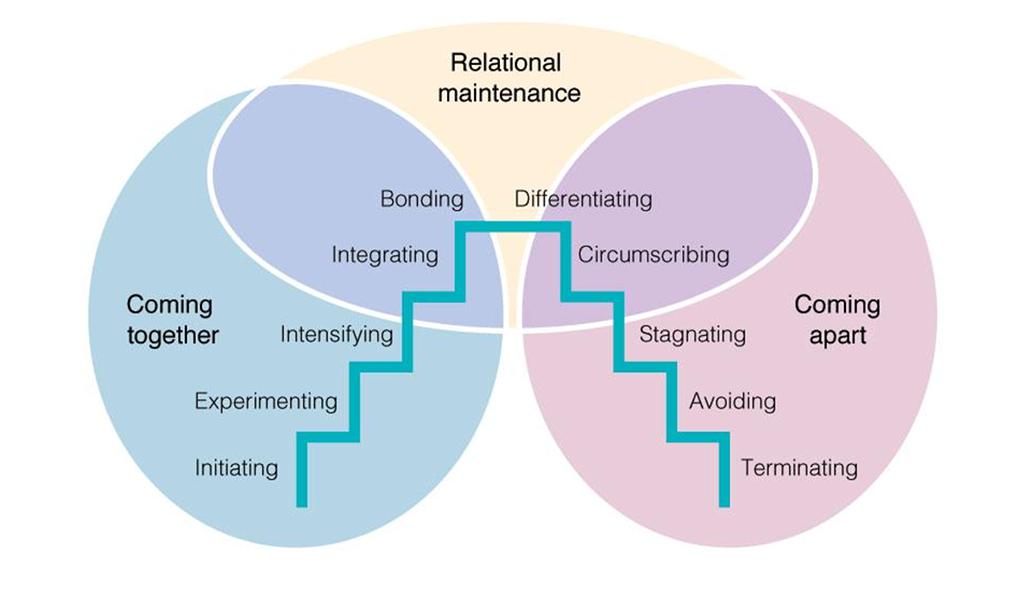Customers are forming relationships with your brand - both good and bad. Thanks to technology, the ability to create meaningful, two-sided relationships between brand and customer is also at a historic high. The best brands see this as an opportunity for using a relationship marketing strategy. By understanding their customers’ wants and needs and having a crisp understanding of the brand's position and value proposition companies can navigate through the stages of relationships and entwine the brand with the customer's identity or aspirational self.
One of the more widely accepted models for relationship stages comes from Mark Knapp in 1998. Knapp’s model contains three integrated phases: Coming Together, Relational Maintenance, and Coming Apart. These phases break into ten stages, which are analogous to brand building. Below is a suggestion on how relationship building and brand building overlap by focusing on the first six stages.

Stage 1. Initiating
Expressing interest in making contact and showing that you are the kind of person worth getting to know.
During the initiation phase, brands are trying to inspire their customers. The brand will put forward its best self. It should tap into the customer’s sense of imagination and aspiration and demonstrate what could be.
Stage 2. Experimenting
The process of getting to know others and to gain more information about them.
Stage 3. Intensifying
An interpersonal relationship is now beginning to emerge. Feelings about the other person are now openly expressed, forms of address become more familiar, commitment is now openly expressed, and the parties begin to see themselves as “we” instead of separate individuals.
During stages 2 and 3, Experimenting and Intensifying trust is being built through a serious of challenges and assurance. As the trust grows so does the user’s willingness to promote the brand. It could be a word-of-mouth recommendation, or it might be as subtle as buying a bag of Starbucks coffee to use at home. Stage 3 demonstrates the beginning of a shift where a brand goes from being a product or service to part of the user’s identity.
Stage 4. Integrating
Identification as a social unit. Social circles merge. Partners develop unique, ritualistic ways of behaving. Obligation to the other person increases. Some personal characteristics are replaced, and we become different people.
When a brand has become a part of the user’s daily routine, it has successfully integrated into the user’s life and has increased its ties to the user’s identity. An example might be going to the YMCA in the morning, or having breakfast on Saturdays at your favorite spot. The brand interaction becomes a habit and can be part of a larger culture (Apple = Creatives, Microsoft = Business).
Stage 5. Bonding
The two people make symbolic public gestures to show society that their relationship exists (rings, friendship bracelets, commitment).
Intensity is the main difference between Stages 4 and 5. While the brand interaction becomes a habit in Stage 4, the commitment may be subconscious and less intentional. Stage 5 represents a very intentional commitment. Users refer to themselves as either Coke or Pepsi people. They get tattoos of the Apple logo or wear necklaces with the Nike swoosh. Wearables use personal health, big data, and style to try and achieve Stage 5 with users. This bond is partially what enables Evernote to move from a digital notebook tool to a physical backpack, printers, wallets, and more. Evernote has a strong understanding of its value proposition that points to their target user. The company has created a strong user experience on the digital front that has led to a heavy Stage 5 Bond, and the opportunity to produce products and services analogous to its core offer.
Stage 6. Differentiating
The need to re-establish separate identities begins to emerge. The key to successful differentiation is maintaining a commitment to the relationship while creating a space for autonomy and individuality.
Stage 6 overlaps between the Relational Maintenance phase and the Coming Apart phase as establishing independence while maintaining a strong bond can be a strong factor in a successful long-term relationship. It feels ironic but goes back to the old cliché, “If you love something set it free…”. When users realize they are not dependent on the brand, but choose them, it allows for a deeper intimacy with a brand. It’s the difference between a new pair of shoes and your favorite shoes. Making a choice is more powerful than satisfying a need. The urge for many companies is to create a stronger sense of need instead of desire. This urge can be a hang up for many companies. Inspire the user to choosing your brand instead.
Thinking about brand building through the lens of relationship building can serve as an evaluation tool to gain understanding on whether or not tactics are helping or hindering your brand. To succeed an organization must have a clear view of its value proposition on a human level, not a corporate level. It also must have a strong understanding of its target audience. These two variables can intertwine the brand with the right audience’s identity.
